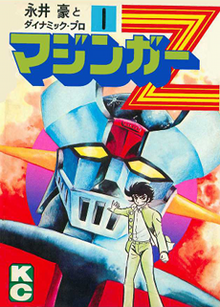
Back مازنجر زد Arabic Mazinger Z Catalan Mazinger Z German Mazinger Z Spanish Mazinger Z Basque Mazinger Z French מאזינגר Z HE Mazinger Z ID Mazinga Z Italian マジンガーZ Japanese
| Mazinger Z | |
 Cover of the first manga volume | |
| マジンガーZ (Majingā Zetto) | |
|---|---|
| Genre | Super robot[1] |
| Created by | Go Nagai |
| Manga | |
| Mazinger Z | |
| Written by | Go Nagai |
| Published by | |
| Magazine |
|
| Demographic | Shōnen |
| Original run | October 1972 – September 1974 |
| Volumes | |
| Anime television series | |
| Mazinger Z | |
| Produced by | Dynamic Planning |
| Written by |
|
| Music by |
|
| Studio | Toei Animation |
| Licensed by | |
| Original network | Fuji TV |
| Original run | December 3, 1972 – September 1, 1974[3] |
| Episodes | 92 |
| Manga | |
| Written by | Go Nagai |
| Illustrated by | Gosaku Ota |
| Published by | Akita Shoten |
| Magazine | Boken Oh |
| Demographic | Shōnen |
| Original run | December 1972 – September 1974 |
| Volumes | 5 |
| Sequels | |
| |
| Other series | |
| Video game | |
| |
Mazinger Z (Japanese: マジンガーZ, Hepburn: Majingā Zetto, known as Tranzor Z in the United States) is a Japanese super robot manga written and illustrated by Go Nagai. It was originally serialized in Shueisha's Weekly Shōnen Jump from October 1972 to August 1973 and Kodansha's TV Magazine from October 1973 to September 1974.
Mazinger Z has since spawned a media franchise. It was adapted into an anime television series by Toei Animation, which aired on Fuji TV[citation needed] from December 1972 to September 1974. A second manga series was released alongside the TV show, this one drawn by Gosaku Ota, which started and ended almost at the same time as the TV show.[citation needed] The series was followed by several sequels and spin-off, among them being Great Mazinger, UFO Robot Grendizer and Mazinkaiser. Mazinger Z: Infinity, a theatrical film sequel, taking place ten years after the Great Mazinger series, was animated by Toei Animation and released in theaters on January 13, 2018.[4]
Although not exactly the first Mecha anime in history, the series has often been cited as being the first modern one.
- ^ "'Mazinger Z' Comes to U.S. Cinemas With 'INFINITY' for Two Special Screenings February 11 and 12 - Anime News Network". Anime News Network. January 19, 2018. Archived from the original on August 12, 2021. Retrieved February 7, 2019.
- ^ Loo, Egan (July 23, 2009). "Mazinger Z, North Star Scriptwriter Susumu Takaku Dies". Anime News Network. Archived from the original on August 25, 2023. Retrieved May 25, 2024.
- ^ "マジンガーZ". Toei Animation. Archived from the original on 2012-10-10. Retrieved 2012-08-13.
- ^ 「劇場版マジンガーZ」 2017年10月にイタリア公開、日本より3ヵ月先行 - アニメーションビジネス・ジャーナル